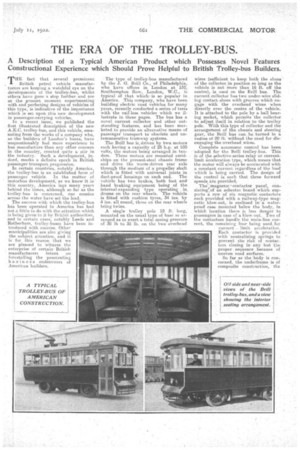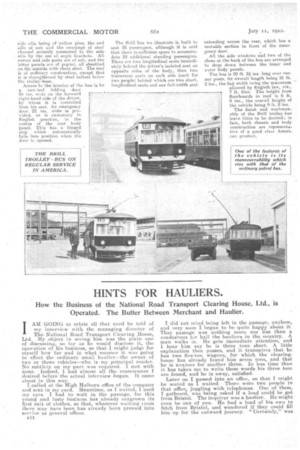THE ERA OF THE TROLLEY-BUS.
Page 11

Page 12

If you've noticed an error in this article please click here to report it so we can fix it.
A Description of a Typical American Product which Possesses Novel Features Constructional Experience which Should Prove Helpful -to British Trolley-bus Builders.
THE fact that several prominent British petrol vehicle manufacturers are keeping a watchful eye on the developments of the trolley-bus, whilst others have gone a step further and are at the present moment experimenting with and perfecting designs of vehicles of this type, is indicative of the importance which is set. upon this new development in passenger-carrying vehicles. In. a recent issue, we published the first, illustrated description of the new A.E.G. trolley-bus, and this vehicle, emanating from the works of a company who, as the builders of London's buses, have unquestionably had more experience in bus manufacture than any other concern in the country, created quite a stir in the industry. Such a development, indeed, marks a definite epoch in British passenger transport progression.
In certain countries, notably America, the trolley-bus is an established form of passenger vehicle. In the matter of motorbus development; as we know it in this country, America lags many years behind the times, although an far as the trolley-bus is concerned, Our cousins across the water have set the lead.
The success with which the trolley-bus ha S been operated in America has had not a little to do with the attention which is being given to it by British authorities, and in certain cases, notably Leeds and Rotherham, trolley-buses have been introduced with success. Othea municipalities are also giving the subject attention, and it. is for this reason that we are pleased to witness the enterprise of certain' British manufacturers intent on forestalling the penetrating .business endeavours of American builders. • The type of trolley-bus manufactured by the J. G. Brill Co., of Philadelphia, who have offices in London at 150, Southampton Row, London, W.C., is typical of that which • is so popular in America. This company, who have been building electric road vehicles for many years, recently conducted a series of tests with the rail-less vehicles which we illustrate in thew pages. The bus has a novel current collector and other outstanding features, and has been mat-'hated to provide an alternative means of passenger transport to obsolete eaid unremunerative tramway systems, The Brill bus ia driven by two motors each having a capacity of 25 h.p. at 550 volts, the motors being arranged in tandem. These motors are mounted amidships on the pressed-steel chassis frame and drive the worm-driven rear axle through the medium of a propeller shaft which is fitted with universal joints in dust-proof housings on each end. The vehicle has two brakes, both foot and hand beating equipment being of the internal-expanding type operating in drums on the rear wheels. The vehicle is fitted with cushion tyres, 34 ins. by 4 ins, all round, those on the rear wheels being twins.
A single -trolley pole 19 it. long, mounted on the usual type of base so arranged as to exert a total spring pressure of 30 lb to 35 lb. on the two overhead
wires (sufficient to keep both the shoes of the collector in position so long as the vehicle is not more than 16 ft. off the centre), is used on the Brill bus. The current collector has two under-wire sliding contact shoes with grooves which engage with the overhead wires when directly over the centre of the vehicle. It is attached to the pole by a ball bearing socket, which permits the collector to adjust itself in relation to the trolley pole. With this type of collector and the arrangement of the chassis and steering gear, the Brill bus can. be turned in a radius of 20 ft: without the need for disengaging the overhead wires.
Complete automatic control has been adopted for the Brill trolley-bus. This is of the aelective,series relay or currentlimit acceleration type, which means that the motor will always be accelerated with a constant current regardless of the load which is being carried. The design of the control is such that three forward speeds are provided.
The magnetic ^cOntactor panel, consisting:of an asbestos board which supports a row of six magnetic contactors each provided with a railway-type magnetic biow-oot, is enclosed ina waterproof case mounted below the body, in which location there is less danger to passengers in case of a blow-out. Two of the contactors handle the main-line current, the remaining four being used_ for Current limit acceleration. Each contactor is provided with neutralizing springs to prevent the risk of cont. tortclosing in any but the proper sequence because oi uneven road surfaces.
So far as the body is concerned, the underframe is of composite construction, the
side sills being of 'yellow pine, the end sills of oak and the crossings of steel channel securely connected to the side ilis by the use of angle brackets. All corner and side posts are of ash, and the letter panels, are of poplar, all sheathed on the outside with sheet steel. The roof is of ordinary construction, except that it is strengthened by steel rafters below the trolley-base.
Access to the interior of the bus is by a two-leaf foldMgdoor 29 ins, wide on the forward right-hand side of the driver, by whom it is controlled fronc his scat. An emergency door 22 ins, wide.. is provided, as is customary in English practice, in the centre of the rear body panel. This has a hinged step which automatically falls into position when the door is opened. The Brill bus we illustrate is built to seat 28 passengers, although it is said that there is sufficient space to accommodate 22 additional standing passengers. There are two longitudinal seats immediately behind the driver's isolated seat on opposite sides of the body, then two transverse seats on each side (each for two people) behind whiclr are two short, longitudinal seats and one full-width seat extending across the rear, which has a movable section in front of the emergency door.
All the side windows and two of the three at the back of the bus are arranged
to n down between the inner and outer body panels.
The bus is 20 ft. 54 ins, long over car. ner posts, its overall length being 21 ft. 2 ins., the full width being the maximum allowed by English law, viz., 7 ft. 6ins. The height from floorboards to roof is 6 ft. 9 ins., the overall height of the vehicle being 9 ft,. 8 ins.
The finish and workmanalifp of the Brill trolley-bus leave little to be desired; in fact, both chassis and body construction are representa. tive of a good class Ameri-. earl product..






























